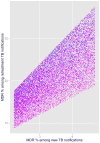Burden of transmitted multidrug resistance in epidemics of tuberculosis: a transmission modelling analysis
- PMID: 26597127
- PMCID: PMC4684734
- DOI: 10.1016/S2213-2600(15)00458-0
Burden of transmitted multidrug resistance in epidemics of tuberculosis: a transmission modelling analysis
Abstract
Background: Multidrug-resistant (MDR) tuberculosis can be acquired through de-novo mutation during tuberculosis treatment or through transmission from other individuals with active MDR tuberculosis. Understanding the balance between these two mechanisms is essential when allocating resources for MDR tuberculosis. We aimed to create a dynamic transmission model of an MDR tuberculosis epidemic to estimate the contributions of treatment-related acquisition and person-to-person transmission of resistance to incident MDR tuberculosis cases.
Methods: In this modelling analysis, we constructed a dynamic transmission model of an MDR tuberculosis epidemic, allowing for both treatment-related acquisition and person-to-person transmission of resistance. We used national tuberculosis notification data to inform Bayesian estimates of the proportion of each country's 2013 MDR tuberculosis incidence that resulted from MDR transmission rather than treatment-related MDR acquisition.
Findings: Global estimates of 3·5% MDR tuberculosis prevalence among new tuberculosis notifications and 20·5% among re-treatment notifications translate into an estimate that resistance transmission rather than acquisition accounts for a median 95·9% (95% uncertainty range [UR] 68·0-99·6) of all incident MDR tuberculosis, and 61·3% (16·5-95·2) of incident MDR tuberculosis in previously treated individuals. The estimated proportion of MDR tuberculosis resulting from transmission varied substantially with different countries' notification data-ranging from 48% (95% UR 30-75) in Bangladesh to 99% (91-100) in Uzbekistan. Estimates were most sensitive to estimates of the transmissibility of MDR strains, the probability of acquiring MDR during tuberculosis treatment, and the responsiveness of MDR tuberculosis to first-line treatment.
Interpretation: Notifications of MDR prevalence from most high-burden settings are consistent with most incident MDR tuberculosis resulting from transmission rather than new treatment-related acquisition of resistance. Merely improving the treatment of drug-susceptible tuberculosis is unlikely to greatly reduce future MDR tuberculosis incidence. Improved diagnosis and treatment of MDR tuberculosis-including new tests and drug regimens-should be highly prioritised.
Funding: National Institutes of Health and the Bill & Melinda Gates Foundation.
Copyright © 2015 Elsevier Ltd. All rights reserved.
Conflict of interest statement
Figures




Comment in
-
MDR tuberculosis control: time to change the dogma?Lancet Respir Med. 2015 Dec;3(12):907-9. doi: 10.1016/S2213-2600(15)00477-4. Epub 2015 Nov 18. Lancet Respir Med. 2015. PMID: 26597129 No abstract available.
References
-
- Global Tuberculosis Report 2014. Geneva: World Health Organization; 2014. [accessed Oct 23, 2014]. http://www.who.int/tb/publications/global_report/en/
-
- da S, Garrido M, Bührer-Sékula S, Souza AB, et al. Multidrug-resistant tuberculosis in the Amazonas State, Brazil, 2000–2011. Int J Tuberc Lung Dis. 2015;19:531–6. - PubMed
-
- Institute of Medicine (US) Forum on Drug Discovery, Development, and Translation, Russian Academy of Medical Science. The New Profile of Drug-Resistant Tuberculosis in Russia: A Global and Local Perspective: Summary of a Joint Workshop. Washington (DC): National Academies Press (US); 2011. [accessed July 27, 2015]. http://www.ncbi.nlm.nih.gov/books/NBK62461/ - PubMed
Publication types
MeSH terms
Grants and funding
LinkOut - more resources
Full Text Sources

